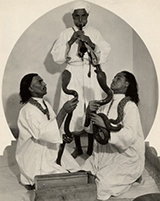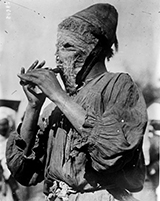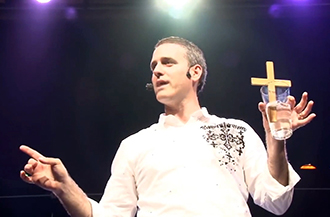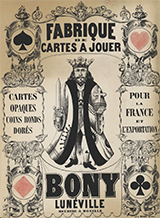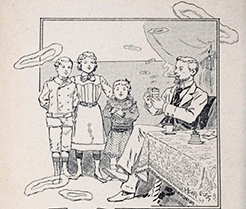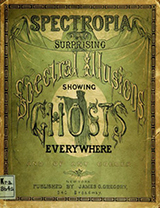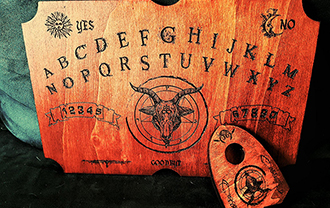by Valentine Losseau
In close-up or close magic, closeness to the audience acts like an effect of reality: astonishment, shock, amazement and wonder are born from the contemplation of an impossibility "seen from close up", in an ordinary context or on stage. This register has been distinguished over time, especially by modern magicians, and does not always correspond to the practices of magic outside the Western area. Nevertheless, many tricks, effects or illusions around the world can be related to it.
Tricks around the world
In India, traditional street magic includes many close magic tricks: the diving duck, a small carved wooden duck that floats in a bowl of water, seems to obey the magician's orders, sitting a few metres away. The gyratory cigarette, placed in balance on a match, spins at full speed without any apparent cause. Raw rice sieved in an apron is transformed into puffed rice. This magical cooking evokes a common trick in rural Haiti, where fresh eggs placed in an apron are transformed into hard-boiled eggs. In the production category, some Indian magicians have mastered the art of making coloured incense or corn powder and pearls appear with their apparently empty hands. The stone spitter spits out heavy stones or metal balls, unwinds multi-coloured threads apparently lodged in his stomach... This magical register is very common in the world. Spitting feathers, mud, metal, small live animals is a sign of election or possession for South American shamans. In Afro-Caribbean cults, there are some initiated people who spit out nails, needles or crushed glass. The same spells are reported in France, where witchcraft is common, especially in cases of bewitchment. In Egypt and Southern Sudan, where ophic cults – related to snakes – are ancient, street magicians practice the trick of the snake turned into a stick. Between illusionism and dressage, this trick evokes the practice of snake charming, common in South Asia and North Africa, where musicians seem to tame cobras, who rise to the sounds of the flute and the drum.
In the "cup trick", a small object seems to travel under walnut shells or metal shells. In India, it is demonstrating a teleportation. But this widespread trick may have been presented differently, in other latitudes: for example, in antiquity, in Egypt and in Greece; throughout the early and late Middle Ages in Europe and in North Africa; during the Renaissance; nowadays in China... by the pebble players, street artists, conjurers, jugglers and magicians. A similar magical structure is found in the Three-card Monte, a demonstration of cheating by tracking a red card between two black cards, practiced in France by the peddlers in public squares. Between amusing physics, cheating, illusionism or witchcraft, the heritage of magic brings together countless tricks practiced in domestic intimacy as well as in the street or on stage.
The mystery at hand
Shortly before 1920, in England, photographs of small winged creatures were released by the Theosophical Society: they would constitute the first close-up shot of fairies, so popular in Anglo-Saxon folklore. The clichés are highly controversial and public figures take part in the "Cottingley Fairies Affair", such as Arthur Conan Doyle, defender of spiritualism, who concludes after a meticulous investigation that the photographs are true – a hypothesis that has been denied many times since. The success of the photographs is explained by an illusion of authenticity due to the apparent proximity of their object, embedded in an a priori harmless context: a green countryside where young girls play and pose. In close magic, the desire to see closely is associated with the use of objects known to all and unsuspected, which can even, according to the magician's protocol, be borrowed from or examined by a spectator: balls, cigarettes, playing cards, tissues, coins, thimbles, elastics...
This centuries-old repertoire is always likely to be enriched and modified. Uri Geller, an Israeli magician, is the author of a genre that has become classic: the twisting and bending of metals by telekinesis. Renewing with spiritualist and metapsychist traditions, he became well known for giving the illusion of bending, twisting, or breaking spoons, keys, and other small metal objects... in a clever conversation between "powers of the mind over matter" and illusionism.
Some shamans, formerly called jugglers, practice magic tricks during therapeutic rites or during shamanic jousting. In the Chukchi – or Shukchi – of the Russian Far East, for example, therapists demonstrate small strings passing through their bodies or those of their patients. Or they give the illusion of multiplying the sound of a rubbed stone on the skin of a drum. In British Columbia, Kwakwaka'wakw – or Kwakiuti – healers seem to manipulate small articulated figurines from a distance.
In Anglo-Saxon countries, gospel magic is a form of magic intended to illustrate Christian mysticism, especially among Protestants. Pastors adapt or create tricks such as the burning Bible, the crucifix through the rope, etc., which they associate with their preaching for the purpose of conviction, pedagogy, sometimes even to preach the mission.
Reference games
From the 19th century onwards, thanks to small objects, magic reached new horizons, for example the world of children's toys. This development is part of the continuity of amusing physics, a playful trend that aimed to introduce people to the mysteries of science by diverting certain optical, chemical or physical properties. Magic boxes become a favourite toy. Always popular, these cases contain close-up and parlour equipment, and are often part of the initiation of professional magicians. The French card game (a set of 52 cards, divided into two colours and four signs) is an example of an object for multiple use: it is used by fortune tellers in divinatory practices, but also as a board game; in many money games (for players and cheats); it forms the basis of the card manipulation repertoire, a very developed register of close magic; finally, it is a juggling object in cardistry, a rapidly growing manipulation practice.
Some magic toys are developed to divert children from the beliefs of their time: this is the case of the book Spectropia, by J. H. Brown, published in 1864, which makes it possible to reveal, at home, "ghosts everywhere, and of all colours".
At the same time, instruments used by mediums to communicate with spirits were patented and sold as toys, such as the famous Ouija table. The illusion of holograms can be found in one of its earlier forms in the Polyoscope, a toy patented in 1852. Nowadays, various playful uses of the smartphone make it possible to create holograms, such as the Palm top theater, a toy that combines a small reflective plastic structure with an application software. The Mindflex game, released in 2009, allows you to manipulate a small levitating ball using the "power of the mind". A playful world, an artistic show, science and magic come together: the border between what is real and what is faked is not always clear and straightforward.




